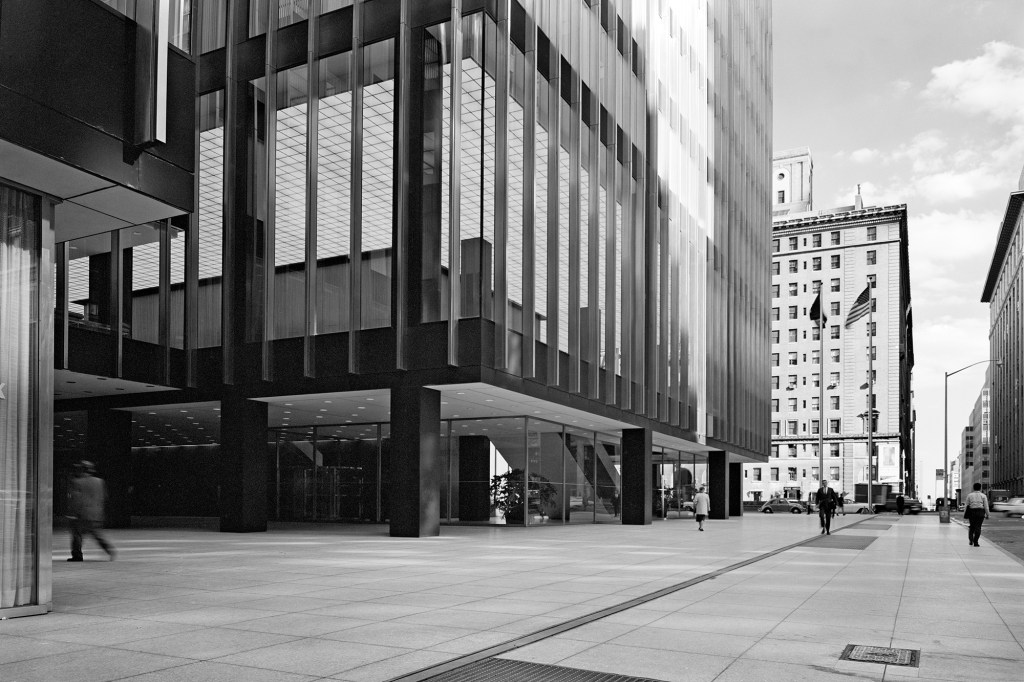One of my most treasured books is a skinny 76-page paperback called Four Walking Tours of Modern Architecture in New York City. It was published in 1961 by the Museum of Modern Art and the Municipal Art Society and written by Ada Louise Huxtable, a couple of years before she became the New York Times’ first architecture critic.
The first tour in the book is a survey of Park Avenue from 43rd to 59th Streets. From time to time, I walk that stretch with Huxtable as my guide. I find her tour to be like a mild hallucinogen, heightening my perceptions of a familiar urban landscape. Because of Huxtable I first came to notice and fall in love with the 11-story Pepsi-Cola World Headquarters building, designed by Natalie de Blois of Skidmore, Owings & Merrill and completed in 1960. Huxtable calls it a “palazetto” set among its much taller, bulkier contemporaries. “By its extreme simplicity, austerity, and careful detailing,” she writes, “the Pepsi-Cola Building asserts its presence with quiet dignity and pride.” Indeed, it’s a gorgeous little office building that appears to magically float above the pavement.
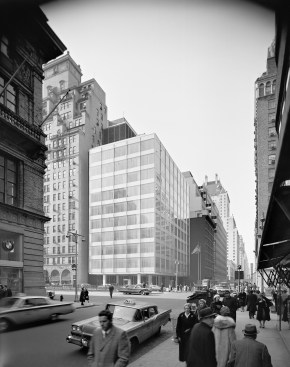
Ezra Stoller/Esto
Pepsi-Cola World Headquarters
Without Huxtable’s guidance, I might have overlooked 460 Park Ave., a 1955 office building designed by the prolific Emery Roth & Sons that is clad in a unique stamped aluminum that was “prefabricated at the factory, [and] installed quickly and easily at the site.” I might not have glanced twice at 445 Park, the Universal Pictures Building by Kahn & Jacobs, a limestone-clad multi-terraced wedding cake completed in 1947. It may not have the glassy shimmer of its more celebrated neighbors—the Seagram Building and Lever House—but, as Huxtable notes, it has an innovative structural system that eliminated interior steel columns and enabled more flexible office layouts. Both are now among my midtown favorites.
To see this stretch of Park Avenue through the eyes of one of New York’s most perceptive architecture critics, who was writing at a moment when all those corporate headquarters were freshly erected, is to visit a version of the city that embodies the optimism and power of the emerging American culture in the postwar decades. Huxtable described it this way in a 1957 feature for The New York Times Magazine: “The staples of our civilization—soap, whisky, and chemicals—have identified themselves with advanced architectural design and their monuments march up the avenue in a proud parade.”
So I was startled to learn that the city now regards this slice of Midtown, not as one of its irreplaceable treasures, but as string of plum redevelopment sites. Because social media has become the voice of officialdom, I discovered this thanks to a series of tweets. “This is big. @JPMorgan will build new headquarters at 270 Park Ave, the first new skyscraper to rise under the East Midtown rezoning,” Deputy Mayor for Housing and Economic Development Alicia Glen wrote in February. “The rezoning is just 6 months old and already it’s bearing fruit. A state-of-the-art building announced that will also trigger a $40M minimum investment from the company in East Midtown’s public realm.”
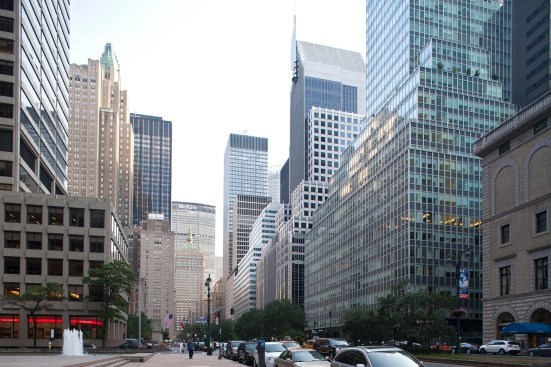
Odyssey-Images
The view looking south on Park Avenue from E. 53rd St.
270 Park Ave., I quickly realized, is stop number two on Huxtable’s tour, a 53-story black glass tower completed in 1960 for Union Carbide. Among architecture critics, the response to the news of its impending demise was outrage. “The Union Carbide Building deserves to continue existing, not because it was in the vanguard of a movement with a dubious urban legacy, but because it’s among the finest of its kind,” wrote Justin Davidson at New York magazine. Alexandra Lange at Curbed noted how unseemly it is for a mayor “who acts as if he has environmentalist bona fides” to be “crowing over what would be the largest voluntary building demolition in the world.” The modernist advocacy organization, Docomomo, wrote a letter demanding that the city’s Landmarks Preservation Commission immediately place 270 Park Ave. on their calendar for possible designation.
I was among those who were surprised that 270 isn’t already a landmark. It has been proposed many times and is old (and intact) enough to be eligible. Even the rezoning plan’s environmental impact statement recognizes its importance, calling it “One of the City’s greatest modern buildings.” And, as New York Times real estate reporter Charles Bagli noted, “Natalie Griffin de Blois, a pioneer in the male-dominated world of architecture, led the team at Skidmore, Owings & Merrill that designed the building.” So, like the Pepsi building farther up the avenue, the tower, while customarily credited to Gordon Bunshaft, was likely designed by a woman.
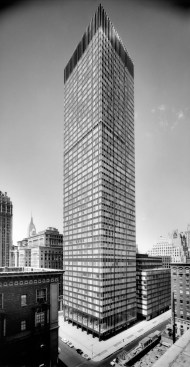
Ezra Stoller/Esto
Union Carbide
A Good Building that Didn’t Get Landmarked
In an effort to understand what the de Blasio administration actually thinks about Park Avenue’s future and the fate of its midcentury inventory, I asked the city agencies involved whether the redevelopment of that stretch is one of the goals of the rezoning. The planning department responded that approximately 16 new buildings will go up within the rezoned area, which consists of the 78 blocks between 39th and 57th Streets and from just west of Madison Avenue to just east of Third. And that “market conditions will determine where redevelopment occurs.”
Landmarks Preservation Commission communications director Zodet Negron emailed me a prepared statement: “Further consideration of this building (270 Park) as a landmark is not among the Commission’s priorities at this time. As part of the interagency East Midtown rezoning initiative, the commission evaluated buildings in the area, including this one. As a result, we prioritized and designated 12 iconic buildings that represented the key periods of development in the area as individual landmarks, but the JPMorgan Chase building was not among them.”
Of the iconic 12, the only modernist building is the Citicorp Center on Lexington Avenue, completed in 1978 and designed by Hugh Stubbins and Associates. According to Simeon Bankoff, executive director of the Historic Districts Council, an organization dedicated to preserving historic neighborhoods, no one really asked for Citicorp to be designated, and, despite the recent demolition of the building’s Hideo Sasaki–designed fountain, it doesn’t seem to be particularly threatened. On the other hand, Bankoff says numerous requests were made to the commission to landmark 270 Park. “We proposed it back in 2013 and they said, ‘You know you’re right. This is a good building. We’ll look at it in the fullness of time.’ And then we sent it again in 2016 and they said, ‘Well, we still hold true to our 2013 [opinion] that this is a good building and we’ll look at it in the fullness of time.’ ”
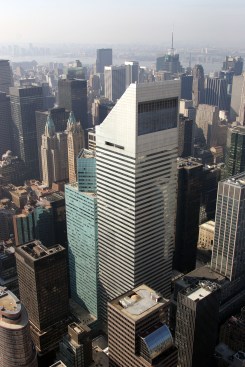
Robert Quinlan
Citicorp Center

The now-demolished Sasaki-designed fountain at Citicorp
Currently, there are three modernist buildings on Park Avenue between Grand Central Terminal and East 59th Street that have been designated as landmarks by the city: Lever House, the Seagram Building, and Pepsi-Cola World Headquarters. All the other midcentury buildings on that stretch, like 270 Park, are not. Some of them, I’ve been told, are too derivative to consider. Others have been heedlessly reskinned or otherwise altered: The most egregious example is 320 Park, a 1961 tower by Emery Roth & Sons. Originally the headquarters of ITT, it was redesigned in 1993 by Swanke, Hayden Connell Architects, which, at the behest of an insurance company, rebuilt the original steel frame outward and topped the building with a late PoMo gable. Preserving some of the original structure allowed the new version to be built to a size allowed by pre-1961 zoning rules. Similarly, 425 Park is the site of a Foster + Partners building, currently under construction, that’s being built atop the bones of another Emery Roth building.
There are endless philosophical arguments for and against making any given building a landmark. Why save this building and not that one? Do you only designate the buildings with the best pedigrees, or do you look at the role that less august ones play in the fabric of their neighborhoods? Do you save modernist buildings at all given that Modernism was, originally, a rebellion against history? At the very least, I wish that the de Blasio administration had had these kinds of discussions. But I don’t imagine it did.
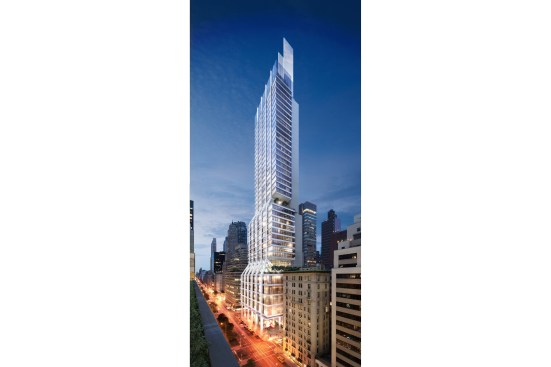
Courtesy dbox / Foster + Partners
A Foster + Partners rendering of 425 Park Ave.
The rezoning document itself is ruthlessly pragmatic. It prioritizes the redevelopment of buildings that have broad swaths of avenue frontage. Park, because it’s an unusually wide street, is a logical site. The same openness that gave the midcentury corporate headquarters here such grandeur will also inevitably doom some of them. The city has decided that the true value of substantial buildings like Universal Pictures is that their sites can accommodate even more substantial buildings. If the former Union Carbide headquarters, one of the best non-landmarked buildings on Park, is now just fodder for the expansion plans of JPMorgan Chase, what chance does a building like Universal Pictures have? Or any building really?
Apart from a Frank Lloyd Wright–designed Mercedes-Benz showroom, a sort of mini-Guggenheim with a spiraling ramp, which was renovated out of existence in 2013, most of the stops on Huxtable’s Park Avenue tour still exist. And so I was struck by a crazy idea: Instead of agitating to prevent the destruction of one building—270 Park—we should be fighting for all of them. Wouldn’t it be remarkable to have a historic district that honors the postwar Modernism that for decades embodied midtown Manhattan?
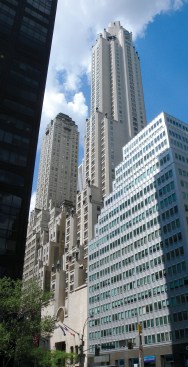
Jim Henderson
460 Park Ave., designed by Emery Roth & Sons
A Historic Empowerment Zone
“It’s funny that you pose this question,” says Robert A.M. Stern, FAIA. The architect whose firm compiled another of my most treasured books, New York 1960, a 1,300-page tome on the midcentury city, admits to having made just such a proposal. “Twenty-five years ago, I was invited to go to one of those breakfast meetings at the Municipal Art Society. And I opined on that very idea, saying that we lost the Park Avenue of the apartment buildings that had grown up after the First World War when the zoning was changed in 1939 or so to allow commercial development below 59th Street. Then all these buildings had been built up. Some very good, like Seagram. Some said to be very good, like Lever, but actually destructive to the streetscape. And others okay, like 270 Park. And a lot of them really banal. But the totality was very interesting. So I argued in my contrary way, I guess, for a historic district.”
Stern’s proposal didn’t go over very well. “The people at the society looked at me as though I was Genghis Khan,” he recalls. “They just couldn’t believe what I was saying.”
I also floated my trial balloon with Theodore Prudon, FAIA, the president of U.S. Docomomo. “In an informal sense, the discussion has come up before,” Prudon tells me. Docomomo had once tossed around the idea of trying to designate a stretch, not of Park Avenue, but of Sixth Avenue, known for its 1960s office buildings. Much that can be said about Sixth Avenue is also true of Park, as Prudon explains: “The whole idea is that you’re dealing with a series of period pieces that are individually maybe not as significant in their own right, but as a collection, they are creating a very clear vision of what they, in that point in time, thought the future would look like.”
Still, Prudon says, “Politically and practically you’d never get anywhere.” He does offer an intriguing suggestion: Give it a different name and the proposal might fly. “Call it a historic empowerment zone,” he suggests.
Andrea Goldwyn, director of Public Policy at the New York Landmarks Conservancy, a nonprofit organization that promotes historic preservation, says, “As an academic exercise, it’s a good idea.” But, she quickly adds, “It’s not viable.” Why? “The city just spent however many years in rezoning East Midtown and allowing buildings especially on Park Avenue, the section you’re talking about, to be replaced by new buildings.”
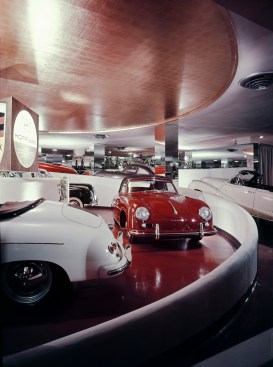
Ezra Stoller/Esto
The Wright-designed Mercedes showroom on Park
The effort to rezone East Midtown actually began during the Bloomberg administration, with a plan that went public in 2012. The plan had a “sunrise provision,” as Bankoff reminds me. It wasn’t supposed to go into effect for five years, to allow the Hudson Yards area to be completed before developers turned to Midtown. The Bloomberg plan, which never became law, was focused most intensively on the area right around Grand Central Terminal. It increased the floor-area ratio (FAR, a measurement of how tall and bulky a building can be relative to its lot size) in the blocks immediately around the train station from 15 to 24, and along Park Avenue from 15 to 21.6. To access the higher FARs, developers would have needed to contribute to a “District Improvement Fund” to spruce up the streetscape and nearby subway stations. “It was zoning for dollars,” Bankoff says.
East Midtown also has a rich inventory of early 20th-century masonry buildings, of the sort that are commonly proposed as landmarks, as Goldwyn notes. “In the original Bloomberg plan,” she says, “those were the ones that were more likely than not to be considered potential development sites.”
Under de Blasio’s rezoning effort, the method of acquiring added FAR changed somewhat. Developers will now have to buy air rights from landmark buildings like St. Patrick’s Cathedral (with some of the money earmarked for the maintenance of those landmarks). The developer will also have to make a donation, based on the size of the air rights purchase, to a Public Realm Improvement Fund. “This is still zoning for dollars, but they dressed it up,” says Bankoff. The bigger change, though, is the FAR; it increased to 27 around Grand Central and 25 on Park, above 47th Street. The 270 Park site occupies a full block in midtown. Multiply the dimensions of that block by 25 (or even 21.6, the FAR on the western half of the block) and it becomes clear how a 53-story tower can become an irresistible redevelopment target.
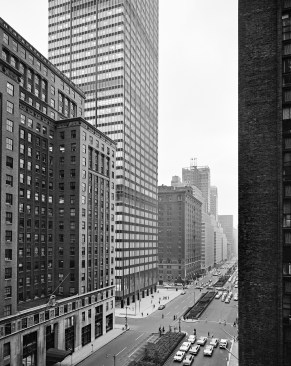
Ezra Stoller/Esto
Union Carbide
Channeling Don Quixote
What’s conspicuously absent in the rezoning plan, and also in the current controversy over 270, is any discussion of Park Avenue as a place—as a genuinely historic place. After taking another walk on Park, looking at both Huxtable’s picks and the buildings in between, I can sympathize with the argument that the modernist version of Park Avenue has become too degraded to preserve. There have indeed been some unfortunate recladding jobs. But even so, I’m not convinced that my idea is without merit.
“Could I create a narrative that Park Avenue is worthy of some sort of aesthetic regulation?” Bankoff asked rhetorically, once he was done laughing at my suggestion. “Definitely.” He concluded: “If somebody wanted to go for it, I’d probably end up supporting them, because I’m that kind of sucker.”
Stern, for his part, accused me of being Don Quixote. Fair enough. But I’ve lately come to think that tilting at windmills isn’t always pointless. If we’ve learned anything over the past year or two, it’s that the maybe best way to counter the dumb mulishness of our current political leaders is with ideas that are big enough to be borderline crazy. So, instead of fighting to save one building on Park, it might be a better strategy to go to the mat for all of them.
